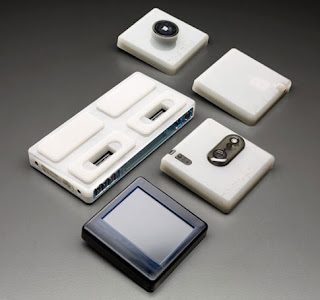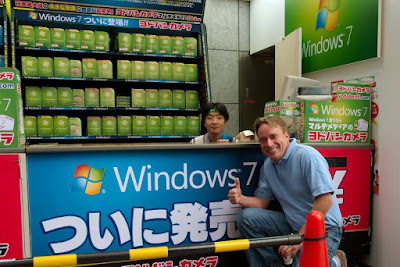Looks like Open source hardware is following Open Source Software way. In previous blogs we discussed Free Telephony project and Bug Labs's Tridgets.
In 2002 Jim Turley predicted bleak future for open source hardware even though open source software is successful in embedded.com.
According to him support, cost, tools, knowledge and manufacturing are the major problems. I will go through these one by one.
Support: Is this a problem only with open hardware, this is will be there for any product which is sold in the market, for this either you buy the support or do it yourself. Payed support will be available from the company which sells the open source hardware products in the market (Just like RedHat in Open Source Software), only thing is you need to pay for that. In the case of do it yourself open source hardware is far better than proprietary hardware, since the entire design is open it is easy for you to fix the bug or enhancing the design.
Cost:Yes Hardware is a costlier thing, developing a new hardware and coming up with a new revision of hardware will cost you money. Will it change if it is proprietary hardware? I think it will cost you more. Let's think from the side of a hardware developer, will the cost take away the interest of the developer from open source development, no I think because every developer coming to community is has some motives in order to achieve this he will be ready to spend some minimal money or personal effort (Just see the number of open source hardware projects coming up, this will become clear). An once a company start(see ATCOM) selling products based on this, it will also help the community. Then manufacturing cost of hardware coming down because of cheap labor available from india and China, see the Gadi Amit of NewDealDesign comment.He says hardware business may be getting easier due to ready-made manufacturing capacity in China, which is driving down the cost of building hardware. The FPGA cost is coming down drastically, this is a very good thing for open source hardware, this has the potential to give more strength to open source hardware movement.
Tools: Yes hardware tools are costly, but who are actually contributing to open source hardware, People who contribute to open source hardware are working already with some hardware company or people who are passionate about that, so both of them will have tools which is needed even if open source hardware is not there.
Knowledge: This is a problem with lazy guys, both open source software and hardware require knowledge, both are equally complex.
So getting back to open source hardware itself, it is licensed under various licenses
GNU LGPL, Creative Commons Attribution-ShareAlike License, MIT License, Ballon Open Hardware License, Hardware Design Public License, TAPR Open Hardware License etc.
Now lets take a took at the popular open hardware projects.
OPLC: The One Laptop per Child association develops a low-cost laptop to revolutionize how we educate the world's children. These Laptops are manufactured by a company called Quanta Computer.
Free Telephony Project: This project develops low cost telephony hardware for developing countries. A Chinese company ATCOM is manufacturing these devices.
Beagle Board: The Beagle Board is a low-power, low-cost Single-board computer produced by Texas Instruments in association with Digi-Key, designed with open source development in mind.
GumStix: Gumstix was initially the name of a single-board computer, developed as a hobby project by Gordon Kruberg. While the design of the main computer boards has always been proprietary, designs for expansion boards are published under a Creative Commons Share-alike license.
OpenMoko: Project aiming to create a customizable, open source smartphone platform based on GNU/Linux. But this project is not in good condition now.
OpenCore: OpenCores is a loose community of people who are interested in developing digital open source hardware through electronic design automation, with a similar ethos to the free software movement.
BugLabs: See the earlier pos.
Arduino: Arduino is a physical computing platform based on a simple open hardware design for a single-board microcontroller.
VIA OpenBook: VIA OpenBook is a free and open laptop reference design from VIA Technologies. It was announced in 2008.
Sun SPOT: It is a wireless sensor network mote developed by Sun Microsystems.
PLAICE: The PLAICE, or FLASH-PLAICE, is a powerful open source hardware device, combining a flash memory programmer, in-circuit emulation, and a high-speed multi-channel logic analyzer.
OpenSPARC: OpenSPARC is an open-source processor project to which Sun Microsystems have contributed the UltraSPARC T1 and UltraSPARC T2 multicore processor designs.
LEON: LEON is a 32-bit CPU microprocessor core, based on the SPARC-V8 RISC architecture and instruction set.
OpenBTS: OpenBTS is an amazing project to build a GSM base station using open source software and hardware. It uses Asterisk as the back end, and can work with standard GSM handsets.
Village Telco: The Village Telco is an initiative to assemble and/or develop the cheapest, easiest-to-setup, easiest-to-manage, scalable, standards-based, wireless local do-it-yourself telephone company toolkit in the world.
Open Graphics Project: The Open Graphics Project (OGP) is developing graphics cards with Free-licensed specifications and Free Software drivers.
Hey! time to stop, see you on next blog.
This blog is about open source way of business. How to combine open source way and free knowledge to bring about innovation and business.
Saturday, October 31, 2009
welcome to ntop community
I found ntop as a good project, but which very much lacks a community. So this is my humble first effort to help that community. I will give preliminary materials which helped me to learn about ntop, I hope this will help others also. Still I am not a contributor to that project, just in the initial phase of code browsing.
Digging Deeper Into Deep Packet Inspection pdf
The BSD Packet Filter: A New Architecture for User-level Packet Capture pdf
Effective Traffic Measurement Using ntop pdf
Ntop Overview pdf
Bloom Filters pdf
Monitoring high-speed networks using ntop pdf
Packet Capture in 10-Gigabit Ethernet Environments Using Contemporary Commodity Hardware pdf
Understand packet processing with multi-core processors pdf
Improving Passive Packet Capture: Beyond Device Polling pdf
Ntop, persistent data and rrd pdf
Introduction to RRD (Round Robin DataBase) html
Optimizing Packet Capture on SMP pdf
Wire-speed Packet Capture and Transmission pdf
Gnu Database Manager (GDBM) pdf
What Every Programmer Should Know About Memory pdf
Enabling Linux* Network Support of Hardware Multiqueue Devices pdf
Towards 10 Gbit NetFlow Monitoring Using Commodity Hardware pdf
High-Speed Passive Packet Capture and Filtering pdf
Evaluating the Performance of Network Protocol Processing on Multi-core Systems pdf
Modern Packet Capture and Analysis: Multi-Core, Multi-Gigabit, and Beyond pdf
Exploiting Commodity Multicore Systems for Network Traffic Analysis pdf
Amitava Biswas Home Page has usefull stuff html
Luca Deri's Home Page contains lots of valuable documents link
Programming with LibPcap -Sniffing the Network From Our own Application pdf
Tcpdump Filters pdf
The Sniffer's Guide to Raw Traffic html
Packet Reading with libpcap html
Programming with pcap html
Perl Compatible Regular Expression Library pdf
Application Layer Packet Classifier for Linux (l7-filter) html
ntop community page html
Enjoy and Help :)
Digging Deeper Into Deep Packet Inspection pdf
The BSD Packet Filter: A New Architecture for User-level Packet Capture pdf
Effective Traffic Measurement Using ntop pdf
Ntop Overview pdf
Bloom Filters pdf
Monitoring high-speed networks using ntop pdf
Packet Capture in 10-Gigabit Ethernet Environments Using Contemporary Commodity Hardware pdf
Understand packet processing with multi-core processors pdf
Improving Passive Packet Capture: Beyond Device Polling pdf
Ntop, persistent data and rrd pdf
Introduction to RRD (Round Robin DataBase) html
Optimizing Packet Capture on SMP pdf
Wire-speed Packet Capture and Transmission pdf
Gnu Database Manager (GDBM) pdf
What Every Programmer Should Know About Memory pdf
Enabling Linux* Network Support of Hardware Multiqueue Devices pdf
Towards 10 Gbit NetFlow Monitoring Using Commodity Hardware pdf
High-Speed Passive Packet Capture and Filtering pdf
Evaluating the Performance of Network Protocol Processing on Multi-core Systems pdf
Modern Packet Capture and Analysis: Multi-Core, Multi-Gigabit, and Beyond pdf
Exploiting Commodity Multicore Systems for Network Traffic Analysis pdf
Amitava Biswas Home Page has usefull stuff html
Luca Deri's Home Page contains lots of valuable documents link
Programming with LibPcap -Sniffing the Network From Our own Application pdf
Tcpdump Filters pdf
The Sniffer's Guide to Raw Traffic html
Packet Reading with libpcap html
Programming with pcap html
Perl Compatible Regular Expression Library pdf
Application Layer Packet Classifier for Linux (l7-filter) html
ntop community page html
Enjoy and Help :)
Friday, October 23, 2009
Friday, October 16, 2009
VMukti: cloud-based HD video communication platform
This is the most active VOIP project in SourceForge. This is an open source P2P Web2.0 audio/video tele conference software for Asterisk/Yate.
VMukti is a video communications cloud-based platform that enables the convergence of voice, video and content over IP (VVoIP application platform) through a distributed peer-to-peer (P2P) platform that supports the construction of a number of video and voice features (or to support pre-built features) in areas of Web conferencing, call-center operation, and distance education, etc. Currently this is a Microsoft Windows only product, since entire software is written in c#. Using Mono project it will be possible to run vMukti on Linux and other platforms.
VMukti is a video communications cloud-based platform that enables the convergence of voice, video and content over IP (VVoIP application platform) through a distributed peer-to-peer (P2P) platform that supports the construction of a number of video and voice features (or to support pre-built features) in areas of Web conferencing, call-center operation, and distance education, etc. Currently this is a Microsoft Windows only product, since entire software is written in c#. Using Mono project it will be possible to run vMukti on Linux and other platforms.
Low cost Telephony on Open Hardware and Open Software
Telephony for Developing countries, this is the main attraction of Free Telephony Project, a open hardware, open source software project started by Dr. David Rowe an Australian engineer.
The main attraction of this is even the hardware design is open, so that anybody can manufacture and modify the products, the project's owners claims $100 per unit cost when manufactured in volume (atleast 1000 pieces). Currently ATCOM a chinese company is offering these products at a price of $400, which is relatively cheap compared to other commercial products.
The main attraction of this is even the hardware design is open, so that anybody can manufacture and modify the products, the project's owners claims $100 per unit cost when manufactured in volume (atleast 1000 pieces). Currently ATCOM a chinese company is offering these products at a price of $400, which is relatively cheap compared to other commercial products.
ntop: Giga speed packet capture
Ntop is a open source projects aimed at Gigaspeed packet capturing on commodity hardware.
Ntop is started by Luca Deri, a computer scientist at University of Pisa,
Ntop is started by Luca Deri, a computer scientist at University of Pisa,
Ntop is based on TNAPI(Threaded NAPI) and PF_RING (new socket interface for efficient packet capture). The entire product is open source(GPLv2) and there are some commercial products based on this manufactured by a commercial spin off of ntop.org .
Subscribe to:
Posts (Atom)




















